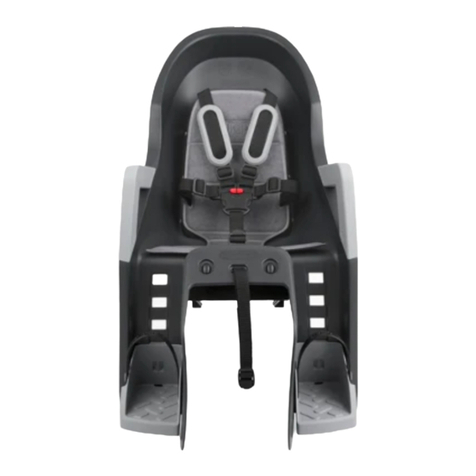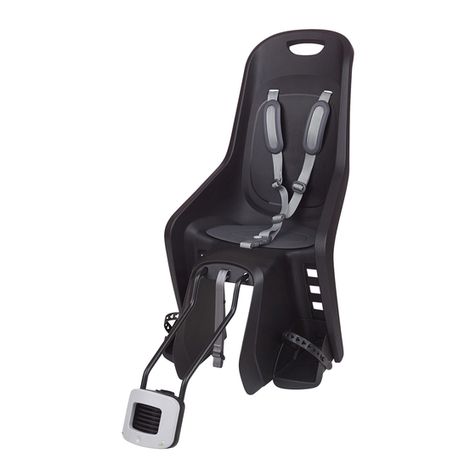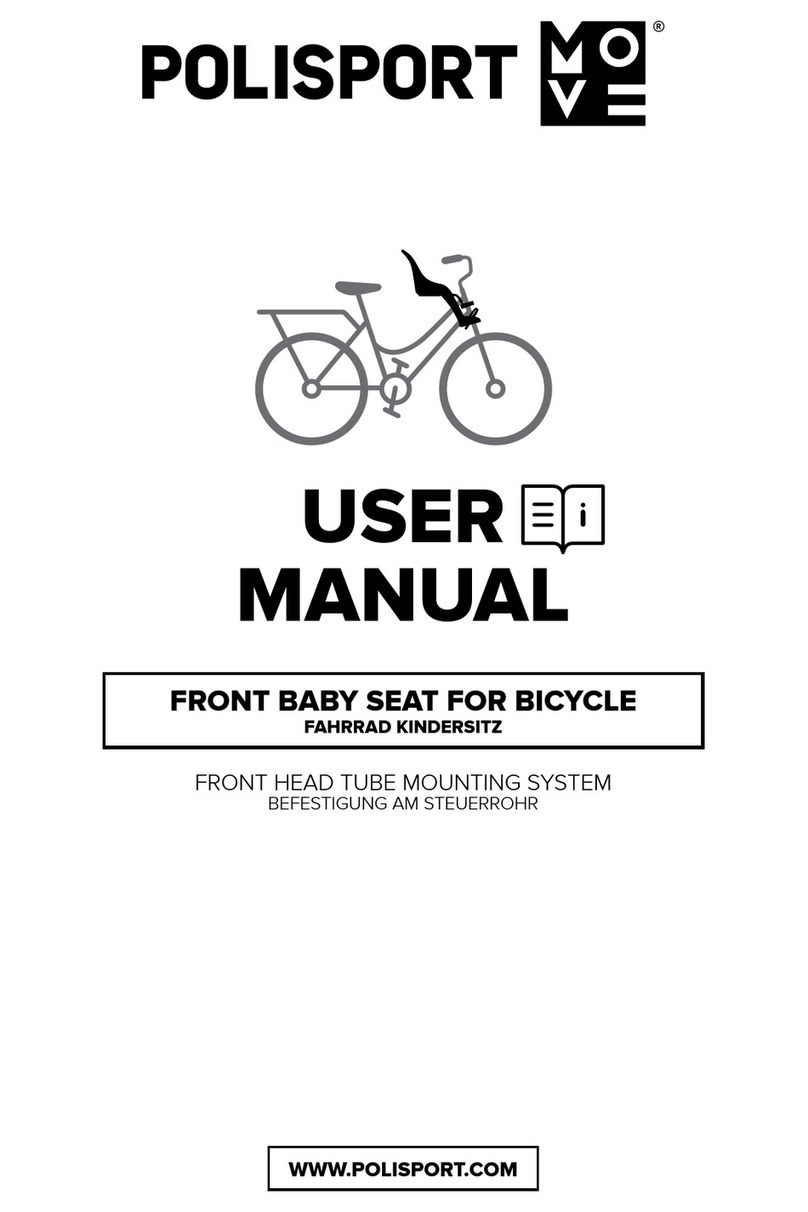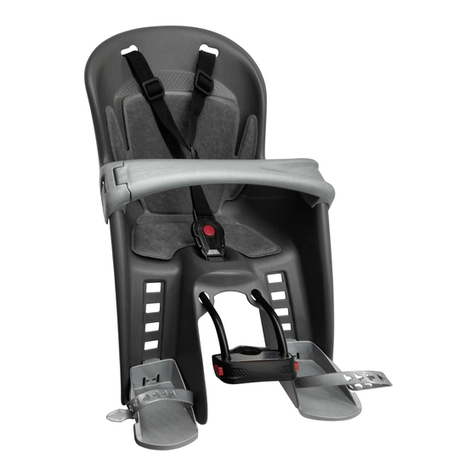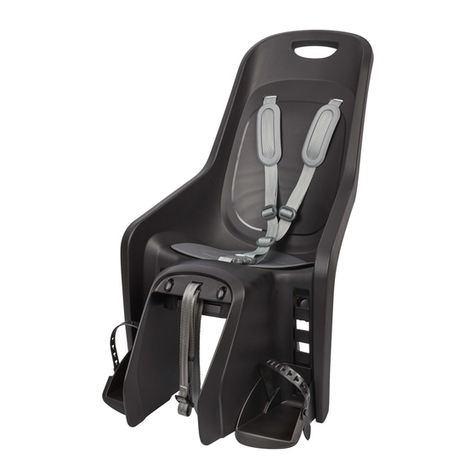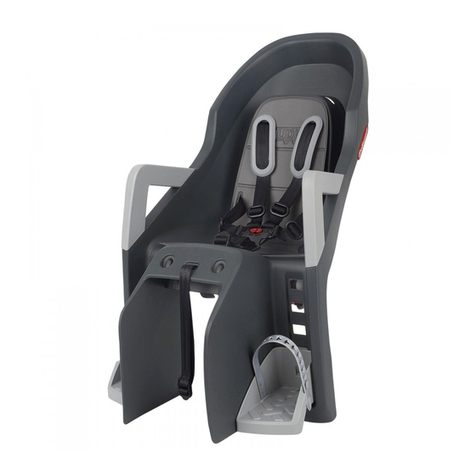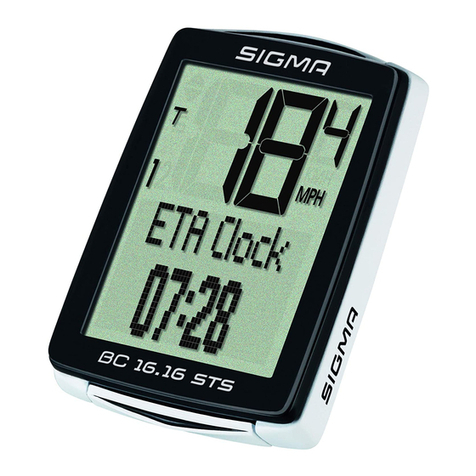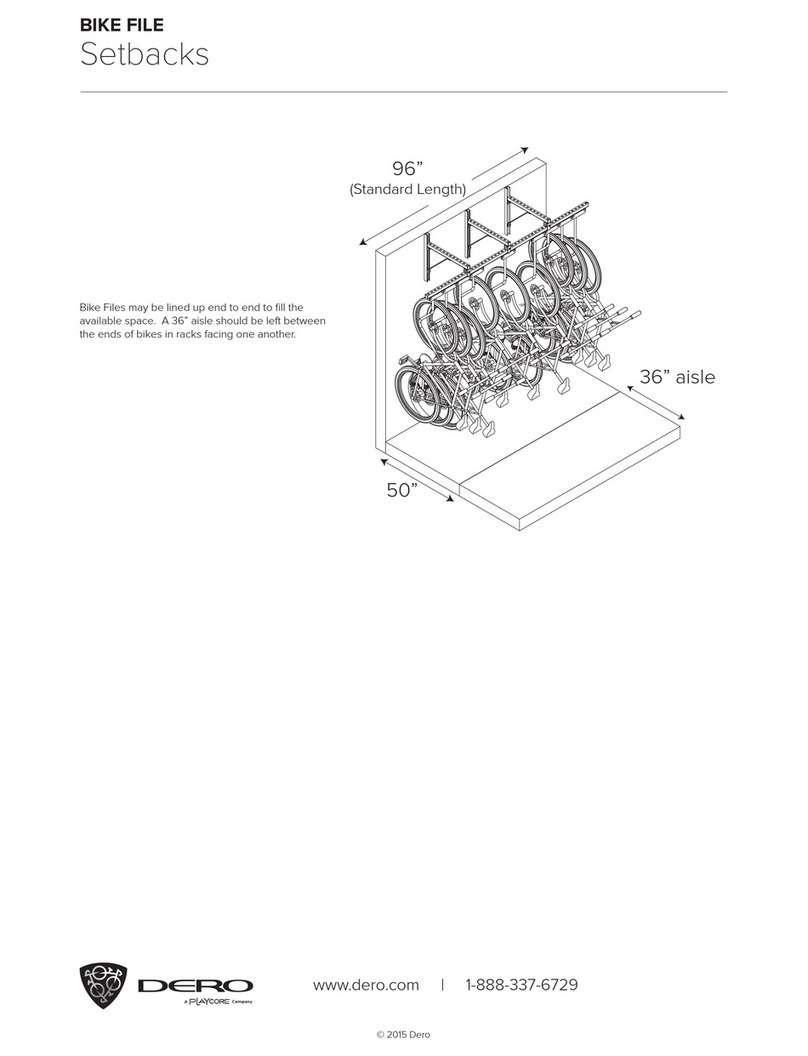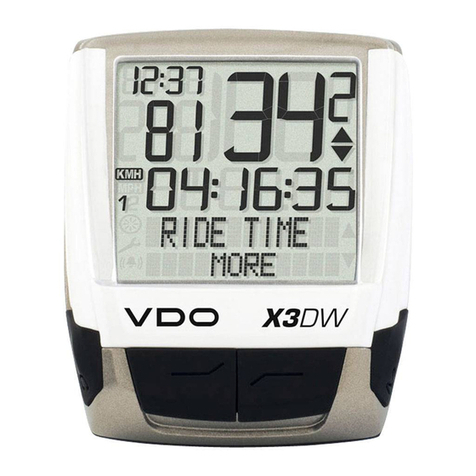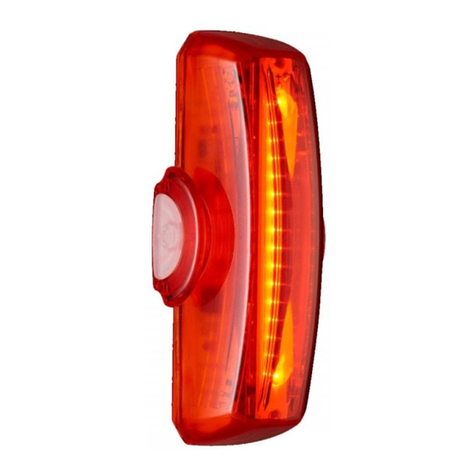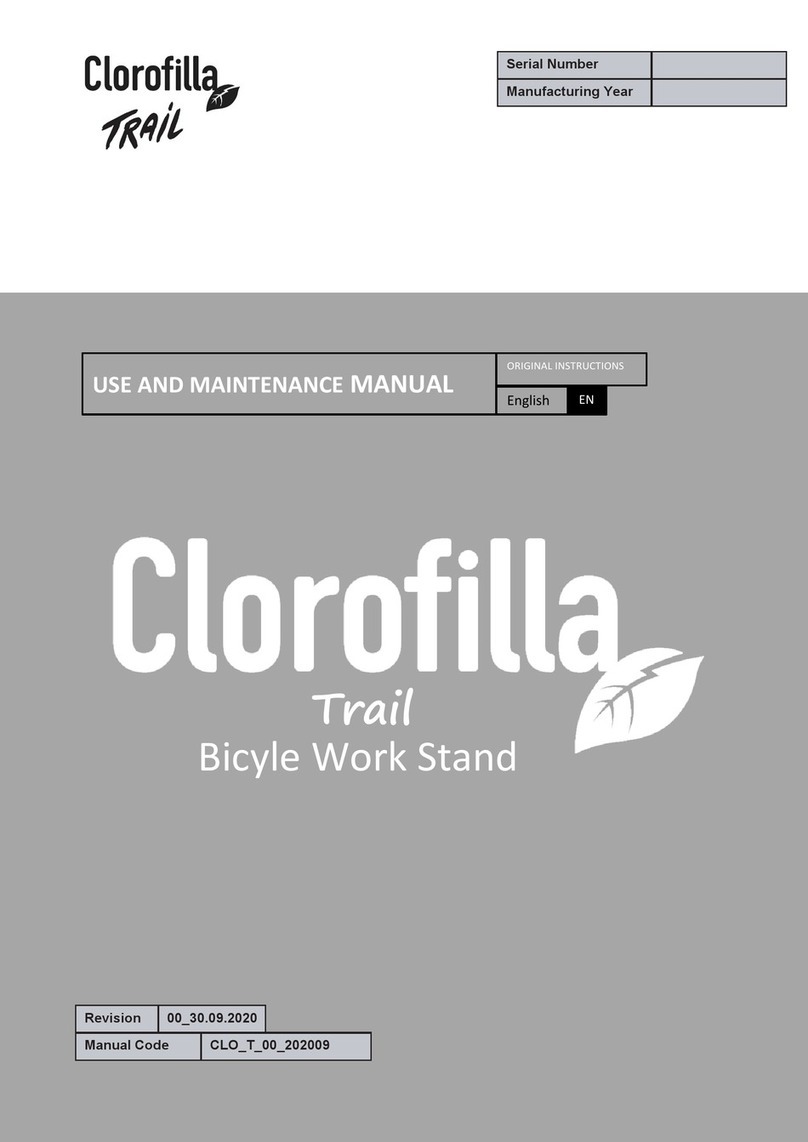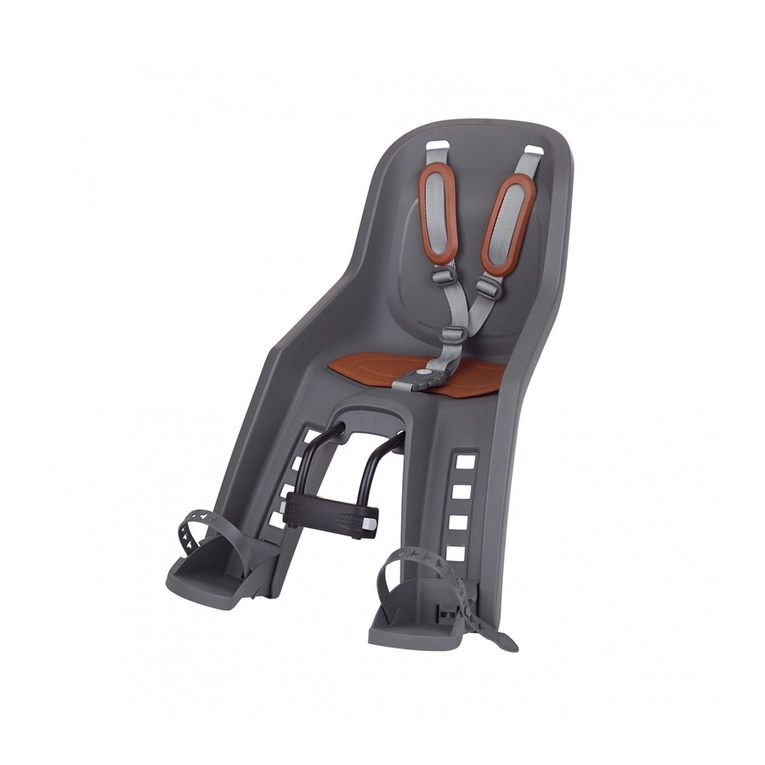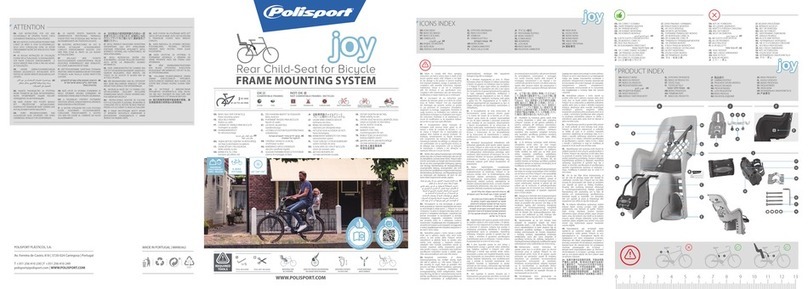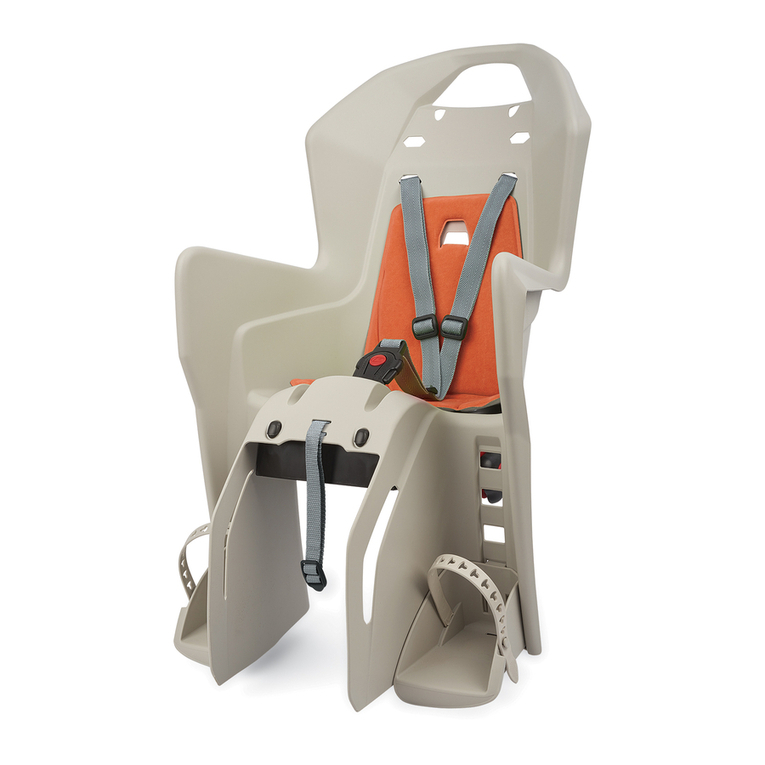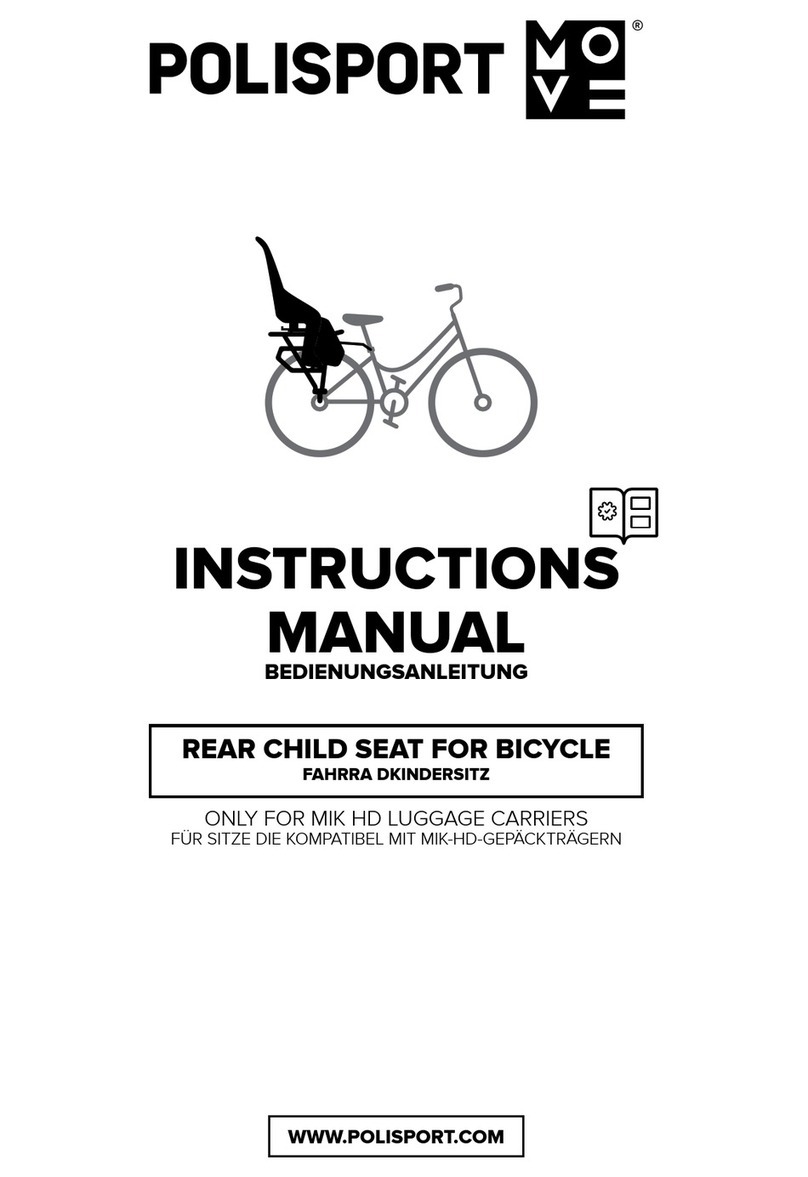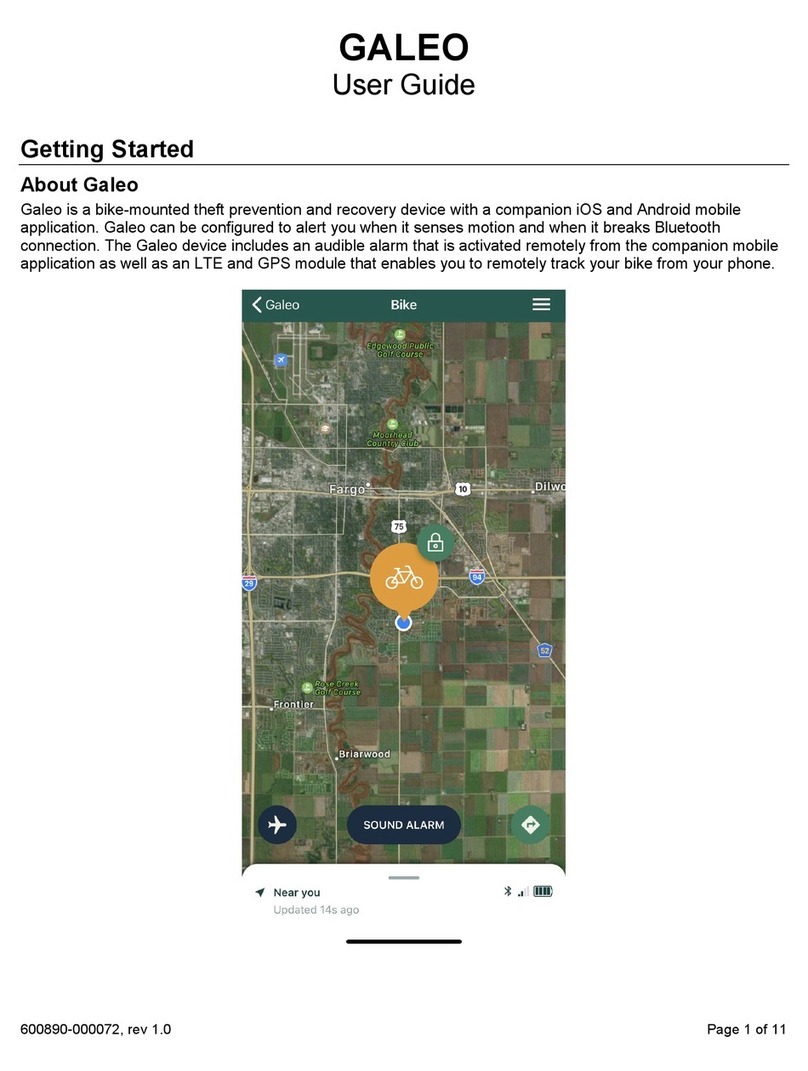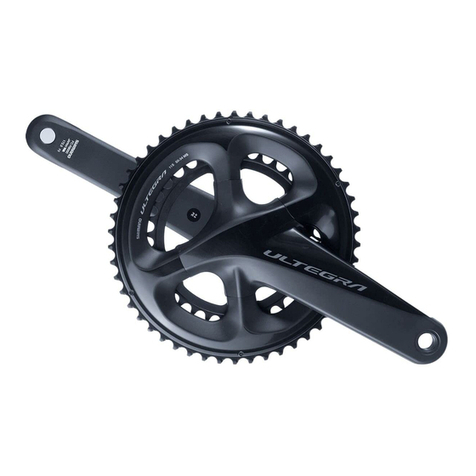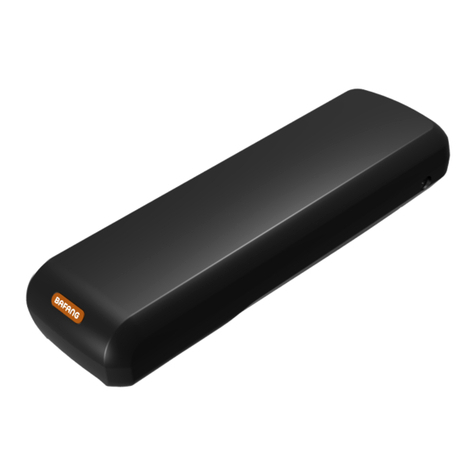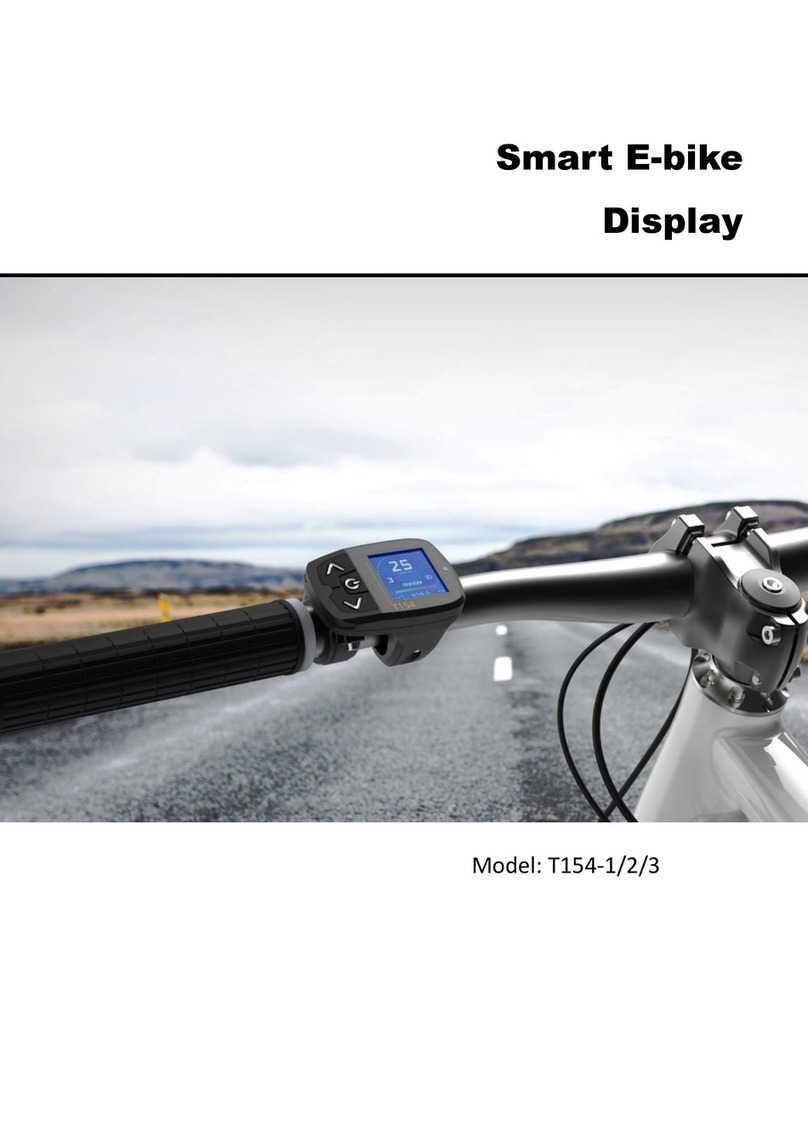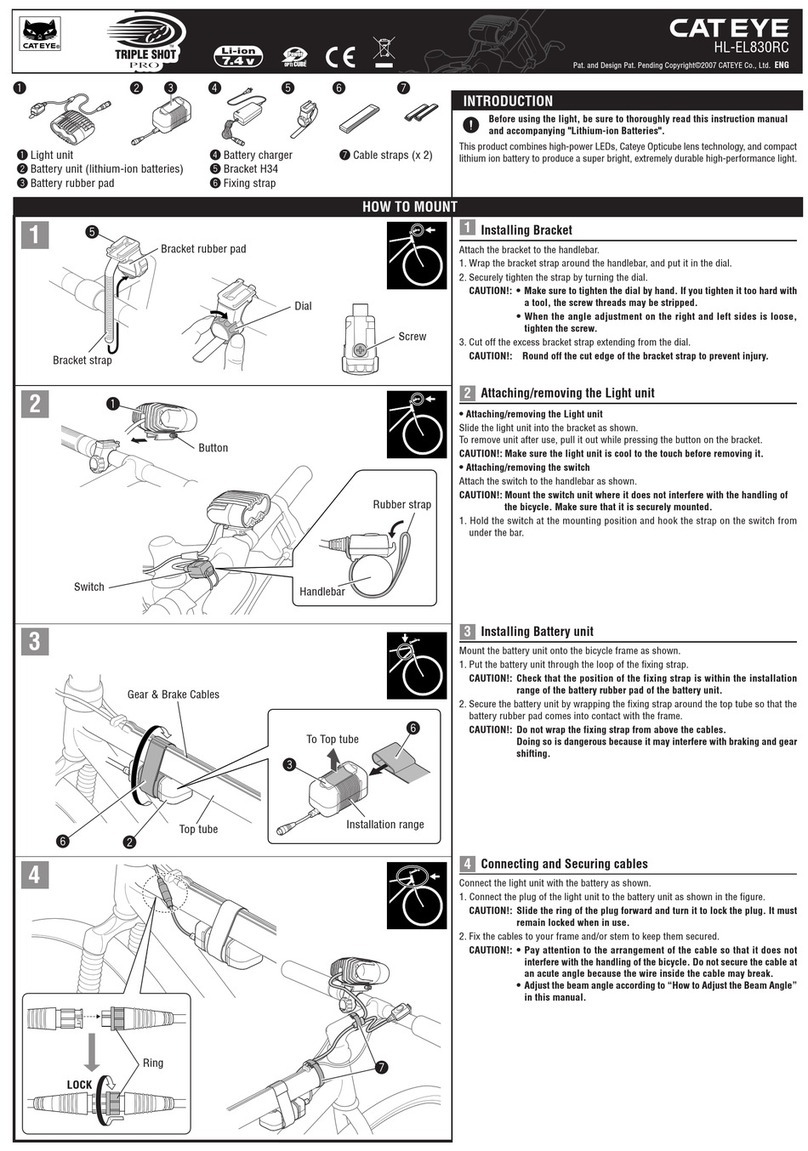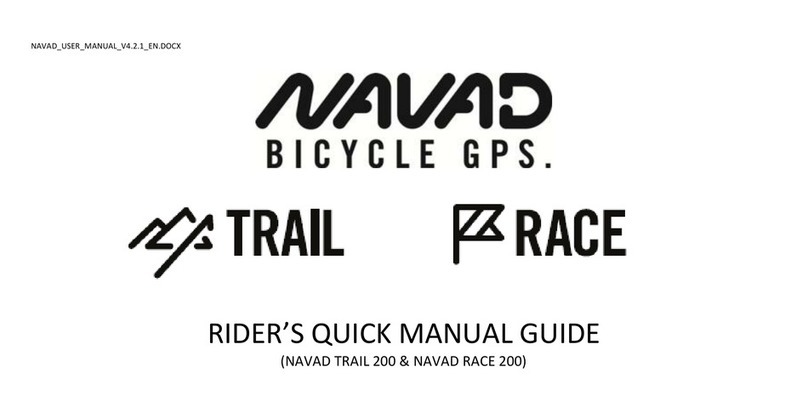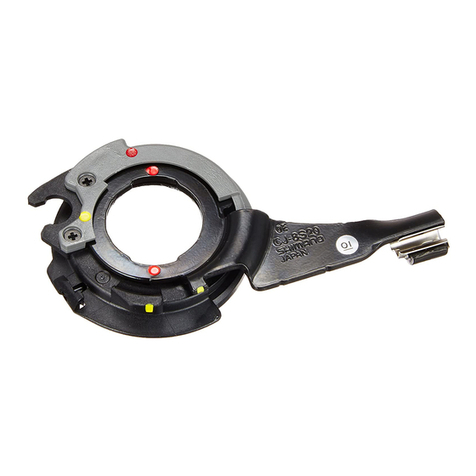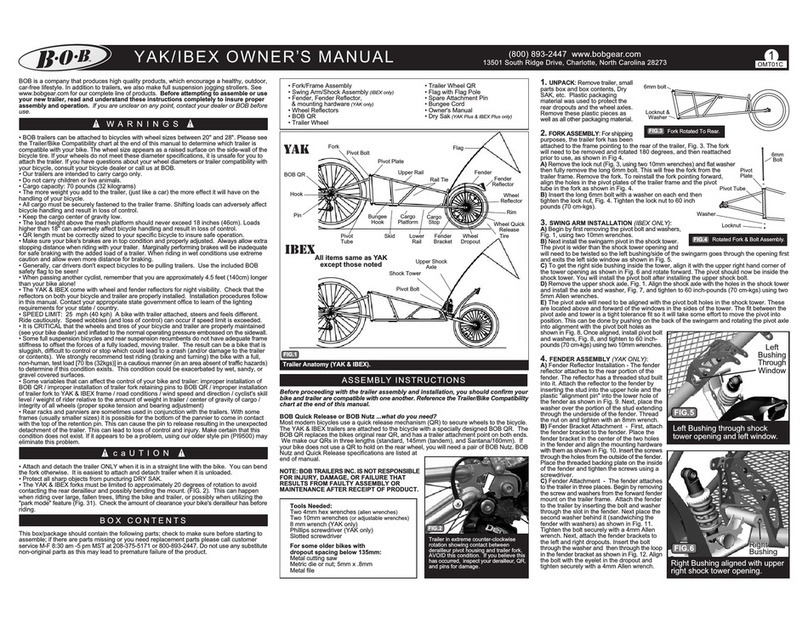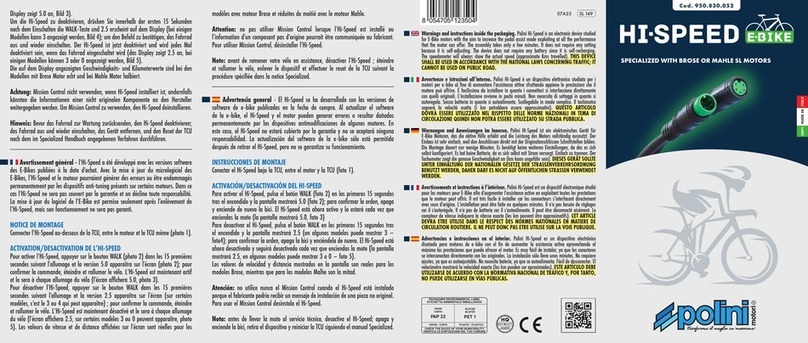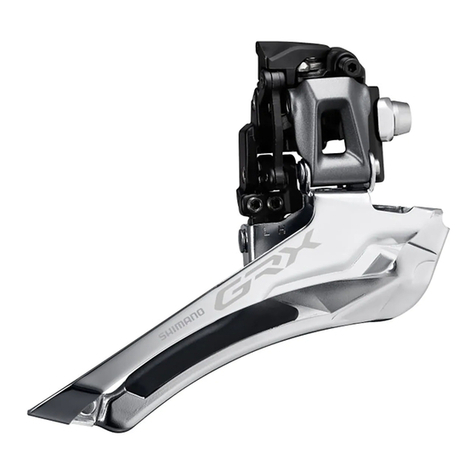
88#polisportmove#polisportmove
INSTRUCTIONS SPÉCIFIQUES DE MONTAGE DU SIÈGE SUR LE VÉLO
1. Couper les bandes en plastique qui retiennent le support (I) / barre de
support métallique (H).
2. Retourner le siège enfant à l’envers comme sur l’image. Utiliser la clé Allen
(I5) pour retirer les vis (J2+J4) et libérer et retirer la plaque de montage de la
barre de support (J1).
2A. Si votre modèle dispose de la pièce H1: Retirer la pièce de fixation
(H1) de la barre de support métallique (H) et la jeter dans le container à
déchets adéquat. Désenclencher la barre de support métallique (H).
2B. Uniquement pour le Bilby RS: out en soulevant l'anneau de sécurité
rouge (L5), dévisser la poignée (L3). Ouvrir la plaque de montage en
plastique (L6).
3A. Sans système d'inclinaison: Saisissez le barre de support métallique (H)
en le tenant comme indiqué sur l’image et passez-le à travers les ouvertures
du siège.
3B. Avec système d'inclinaison (Guppy RS+, Groovy RS, Bilby RS): Placez
la barre de support métallique (H) sur la plaque du système d'inclinaison et
passez-la à travers l'ouverture de la plaque du mécanisme (L).
4. Dans le but d’ajuster le siège vélo enfant à la taille du vélo, fixer le barre de
support métallique (H) sur l’une des positions possibles afin de déplacer le
siège vers l’arrière ou l’avant. Au départ, nous suggérons de le placer sur la
position nº 1. Le siège doit être installé aussi proche que possible de la selle.
5A. Insérer la plaque de montage de la barre de support (J1) dans les
rainures du siège (A) et la fermer comme sur l’image. Si votre modèle dispose
de la rondelle (J3), veuillez vous assurer que celle-ci est correctement placée
dans la rainure arrière du siège de vélo (A1). Insérer la fixation vis (J2) sur
l’orifice arrière de la plaque de montage de la barre de support (J1). Veuillez
noter que l’écrou (J5) sous le coussinet peut se relâcher si vous serrez ou
desserrez la plaque de montage de la barre de support (J1). Vous devez saisir
l’écrou, le placer correctement dans la rainure du siège en serrant totalement
tout le système à l’aide de l’autre main. Nous recommandons l’utilisation
d’un couple de serrage de 5 N.m. En procédant de la sorte, vous assemblerez
la plaque de montage de la barre de support (J1) et la barre de support
métallique (H) au siège (A). Cette étape est extrêmement importante pour
la sécurité du cycliste et de l’enfant.
5B. Uniquement pour le Bilby RS: Fermez la plaque de montage en
plastique (L6) en la poussant vers le bas comme indiqué sur l'image, de
manière à ce qu'elle soutienne la barre de support métallique (H). Placez et
serrez poignée de fixation (L3) jusqu'à ce que vous vous assuriez que le levier
de sécurité est correctement maintenu comme indiqué sur l'image. La barre
de supporte métallique (H) est maintenant solidement fixée au mécanisme
d'inclinaison du siège (L).
6. Emboîtez les protections pour repose-pied (E3) sur le corps du siège (A).
Vérifiez qu’elles sont placées correctement. Cette étape est extrêmement
importante pour la sécurité de l’enfant.
7. Desserrez les vis (I1+I6) du support de cadre (I), à l’aide de la clé Allen n°5
(I5).
8. Le positionnement correct du support de cadre (I) est extrêmement
important - assurez-vous qu'il est positionné dans le cadre de la bicyclette
conformément à l'image - de l'avant et assemblé sur le tube de selle et
jamais assemblé sur la tige de selle. Avant de placer le (I) sur le cadre, vérifiez
que le caoutchouc de protection (I8) est correctement positionné à l’avant
du bloc de fixation (I2). Placer le corps principal du bloc de fixation (I2)
devant le cadre du vélo, et placer ensuite la plaque de fixation métallique (I4).
Note: S’il existe des câbles dans cette zone, vérifiez qu’ils soient correctement
rangés dans la fente centrale de la plaque métallique (entre le caoutchouc de
protection (I7) et la fente de la plaque de fixation (l4) et qu’ils peuvent se
mouvoir librement). Placer la rondelle (l6) dans les vis M8 (l1) et ensuite
vissez-les sur le support de cadre (I). Veuillez noter que le support de cadre (I)
doit être sécurisé mais sans être totalement serré afin que, si nécessaire,
pouvoir ajuster la hauteur plus tard, selon les exigences du Centre de gravité.
Cependant, veuillez noter qu’il doit être suffisamment serré afin de faciliter la
réalisation de l’étape de positionnement de la barre de support métallique
(H) et du siège.
9. Tirer vers le haut la ceinture de sécurité vers le cadre du vélo (C). Veuillez-
vous assurer qu’il n’entrave pas le montage du siège sur le vélo.
10. Modèle A: Placer les bords de la barre de support métallique (H) sur les
ouvertures du support de cadre (l) jusqu’à percevoir un «click», indiquant la
fermeture, et jusqu’à ce que les 2 indicateurs verts du dispositif de sécurité
surgissent devant le bloc de fixation. Le siège vélo enfant ne sera
correctement installé que lorsque les 2 indicateurs verts du dispositif de
sécurité seront visibles. Cette étape est extrêmement importante pour
sécurité de l’enfant.
Modèle B: Adapter les coins de la barre de support métallique (H) sur les
orifices du support de cadre (I) jusqu’à entendre un clic indiquant un
verrouillage et jusqu’à ce que le bouton du centre (I3) soit au niveau de
l’extérieur du support du cadre du tuyau (I).
11. Centraliser et ajuster la barre de support métallique (H) à la hauteur au-
dessus de la roue arrière, afin que, plus tard, lorsque le poids de l’enfant
s’ajoutera, le siège enfant du vélo ne touche pas la roue.Veuillez noter que la
barre de support métallique (H) doit se trouver sur une position maximale de
10 cm de la roue. Ne jamais utiliser cette a barre de support métallique (H)
pour transporter d’autres poids que ce siège enfant, comme indiqué dans ce
manuel.
12. Le siège vélo enfant dispose d’un centre de gravité (F) (inscrit sur le siège
vélo enfant) qui doit être placé devant l’axe de la roue arrière. S’il est placé
derrière l’axe, la distance ne doit pas dépasser 10 cm. Une prudence
particulière s’impose au moment de placer le siège vélo enfant afin de
garantir que le cycliste ne touche pas le siège vélo enfant avec ses pieds en
roulant. Note: En Allemagne, conformément à la législation routière StVZO,
les siège vélo enfant ne peuvent être installés sur le vélo qu’a contition que
les 2/3 de la profondeur du siège ou le centre de gravité du siège se situe(nt)
entre l’axe avant et arrière du vélo.
13. Après avoir ajuster la hauteur et la position du siège, serrez manuellement
le support de cadre (I) afin d’assurer qu’il ne bouge pas. Vous devez
absolument serrer manuellement les vis en diagonale, en employant la
même force et par étapes. Nous recommandons l’utilisation d’un couple de
serrage de 10 N.m (Modèle A) / 8 N.m. (Modèle B). Veuillez-vous assurer que
le support de cadre (I) est bien attaché.
14. Commencez par ouvrir la boucle de ceinture de sécurité (C1) et passez-la
autour du cadre du vélo. Ajustez la ceinture comme sur l’image, sous tension.
Assurez-vous que la ceinture détendue restante ne reste pas en contact avec
la roue ; pour cela passez-la à travers le dispositif de rétention. Cette étape
est extrêmement importante pour la sécurité du cycliste et de l’enfant.
15. Uniquement pour le Guppy RS: Ne pas dépasser le poids limite de 1 kg
supporté par le filet de transport (M). Au total, le poids maximum
comprenant celui de l’enfant ainsi que des objets transportés dans le filet ne
peut pas dépasser le poids recommandé de 22 kg.
la capacité maximale autorisée du vélo. L’information relative à la capacité
maximale peut être trouvée dans les instructions de fonctionnement du
vélo.Vous pourrez également contacter le fabricant sur cette question.
• Ce siège enfant de vélo ne doit pas être utilisé sur EPAC / Pedelecs dont la
vitesse est supérieure à 25 km/h / 15,5 mph.
• Le siège ne pourra être monté que sur un vélo adapté à la fixation d’une
telle charge supplémentaire. Veuillez consulter le manuel d’instructions de
votre vélo ou porte-bagages.
• La position du siège vélo enfant doit être ajustée afin que le conducteur ne
puisse pas le toucher avec les pieds lorsqu’il pédale.
• Il est très important de régler correctement le siège et ses composants
afin d’offrir à l’enfant une sécurité et un confort optimal. Il est également
important que le siège ne soit pas incliné vers l’avant afin d’éviter que
l’enfant ne glisse hors du siège. Il est également important que le dossier soit
légèrement incliné vers l’arrière.
•Vérifiez que tous les éléments du vélo fonctionnent correctement lorsque le
siège vélo enfant est monté.
• Vérifiez les instructions du vélo et en cas de doute sur l’ajustement du siège
vélo de l’enfant à votre vélo, veuillez contacter votre distributeur vélo pour
plus d’information.
